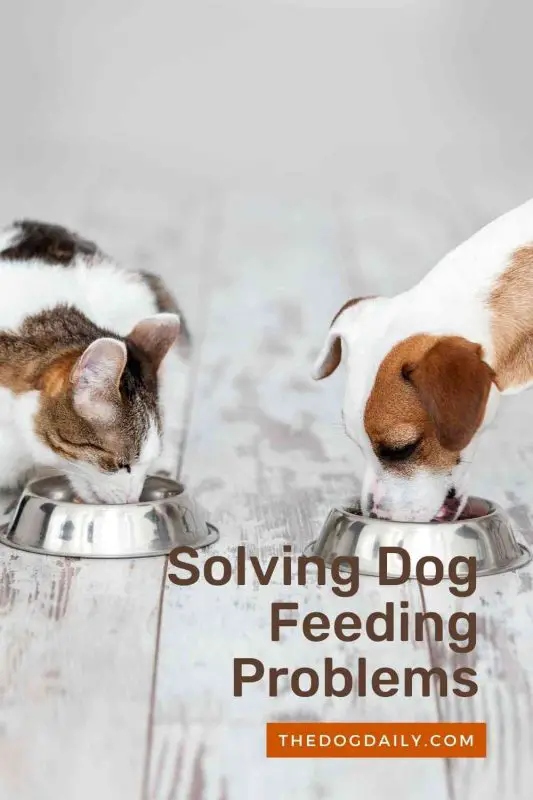How To Avoid Common Dog Feeding Issues
When George Kingsley‘s seven-year-old Pug Sophie began vomiting a couple of times per week after meals, he quickly asked her veterinarian about the problem. “My vet describes her, politely, as being ‘not a delicate eater,’ which means she scarfs down her kibble,” the Brooklyn, New York, dog owner says. “He suggested giving her each meal in smaller portions so that the food would have time to move through her digestive tract. Now I give her half her breakfast when I get up, and the other half 30 minutes or so later, and do the same with dinner.”
Portioning solved Sophie’s problem with keeping her food down. For this and other sometimes-elusive solutions to common mealtime blunders, Gail Buchwald of the ASPCA offers nine quick and easy fixes.
In Multi-Pet Homes, Cats and Dogs Or Two Or More Dogs Eat Side By Side.
Multiple pets should have separate eating areas to avoid competition over resources and food guarding behaviors. “Create a calm feeding environment. It will help your pets’ digestion,” says Buchwald.
Some Mornings You’re Out the Door By Seven, While Others You’re In Bed Past Nine. Fido Is Fed Soon After Your Alarm Goes Off — Whenever That May Be.
When you sleep in, feed your furry friend as soon as you wake up. When you’re leaving home early, don’t pour the kibble until you’re just about to leave. “Dogs need to maintain a regular feeding schedule,” says Buchwald.
Heaping Bowls Of Food Have Left Your Always-Hungry Pooch Without A Waistline.
Talk to your veterinarian about a healthy weight for your dog and its ideal caloric intake — then change your pet’s diet accordingly. “There’s a huge obesity problem among dogs,” says Buchwald. “Vets see more and more of it, along with the weight-related conditions that we see in people, like diabetes and arthritis.” To protect your dog’s health, whittle its waist.
Your Dog Licks Its Bowl, So Why Waste Water Washing It?
When feeding wet food, the bowl should be washed after every meal. With dry food, washing every other day should be sufficient. And don’t forget the water dish (clean with soap and water once a day). “Dirty bowls harbor bacteria,” reminds Buchwald.
Every Time Rover Pleads With Those Big Brown Eyes, You Melt and Give Him What He Wants: A Treat.
Give pieces of treats rather than entire biscuits, or substitute a canine-friendly vegetable (e.g., a green bean) for a cookie. “Treats should make up less than five percent of a dog’s daily caloric intake,” advises Buchwald.
Your Post-Breakfast Walk Occurs Immediately After the Morning Meal and Often Includes a Brief Jog.
You can’t run on the treadmill after eating, and neither should your dog. Wait 30 minutes between mealtime and exercise.
The Pet Store Is Out Of Your Dog’s Favorite Kibble, So You Purchase Something Else and Begin Using It That Very Night.
Be sure to shop for your pet’s food when you still have a week’s supply. If you need to change, make the switch gradually over one week. “Start with a quarter cup of the new food and three-quarters cup of the old for one or two days, seeing how your dog tolerates it. If everything goes smoothly, move on to 50-50 for a couple of days, and then a quarter cup of the old food mixed in with three-quarters of the new,” advises Buchwald.
Your Dog’s Only Meal Is In The Morning.
Like people, dogs need to eat more than once a day. Daily breakfast and dinner are ideal. “Dogs are diurnal, like us. They’re up with the sun and ready for sleep at night, and they need nutrition throughout the day.”
Who Could Resist That Face Begging At the Dinner Table? Leftovers From Your Plate Always Find Their Way Into Your Dog’s Mouth.
Create a no-table-scraps policy and stick with it. “What we eat is not healthy for our dogs,” says Buchwald. Besides contributing to obesity, people food can cause stomach upset or even death for our best friends. The list of forbidden foods is long, and it’s difficult to avoid them all. A no-go rule is your best antidote to this problem.
Of course, dog feeding isn’t an exact science. Become familiar with your dog’s food-related behaviors, as well as ahem, “output.” Changes in Fido’s gustatory patterns can clue you in that the menu, or its delivery, warrant further examination. Your dog’s stomach will thank you for it.
Are People Food Snacks Bad For My Dog?
Let’s say you take your dog on a walk, and, along the way, you decide to stop at an outdoor cafe, and your dog finds some snacks lying on the ground. If you’re like me, you do whatever you can to make sure your dog does not eat anything off the sidewalk. Potato chips, bread crumbs, and pickles aren’t, after all, part of a dog’s regular daily diet. But honestly, how much damage can a quick snack do?
The answer is, every dog from both behavior and dietary perspective is different. Some dogs can eat a snack, and it won’t harm their dietary routine; others might get the wrong idea and start begging for anything other than what’s in their bowl.
Article written by Author: The Dog Daily Expert

